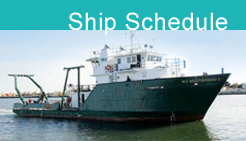Deep Sea Fish and Sediment Surveys in the Gulf
More Thursday adventures
Posted by K. Bylsma C-IMAGE Teacher at Sea 8/08/13
The day started again at 0600. The SIPPER was finishing from last night’s late deployment ( we finished filtering water samples at 0100 !!)It’s quiet from a work standpoint, but Thomas is busy in the galley and the crew is gathering for breakfast. Jonelle is the only scientist up and ready at this point. We’re not deploying the CTD until 0800, so there’s some time to acclimate again. Sunrise is scattered clouds- more like summer weather. Several oil platforms still readily visible from this in transit location.
Gino ( engineer) called our attention to one of the rigs late last night that was “fired”, meaning that they had tapped their source from the rig and were burning the source- which answers the question , “ are the rigs operational?” Now, I’m wondering what fossil fuel source they actually tapped into and at what depth?
Questions, always questions.
All around me, there are relationships represented ( no, not those kind of relationships) , but the ones between 1/ organisms, 2/ systems ( mechanical, biological, etc.) , fields of study, etc. How do we measure these relationships ? ( Otherwise, how do I know that there is a relationship?)
Teachers:
1/ Start with organisms… ( examine this graphic that I located in my research)
This graphic organizer is , by no means comprehensive, but the questioning is a starting point – use it for identifying trophic levels, predator/ prey roles, etc. I like the energy flow, personally.
2/ From a systems approach, I have been analyzing and trouble shooting our water analysis system . Students could use our photos to do the same for the winch system, the bongo system, or other systems on the vessel.
3/ During this excursion, I’ve observed and participated in a number of interactions between the various represented fields of science. Again, students could be encouraged to use our photos and background research to create scenarios that describe these relationships, ie. an ecologist recognizes an issue in their data and creates a driving question. They present this issue to a colleague – chemist, biologist, etc. Since this pair of scientists now see common concerns ( from varying perspectives), they consult an engineer, who redesigns their data collection system to more accurately collect data to study this driving question. Just a thought. I found interesting career information at http://www.coolclassroom.org/home.html if that suits your needs. In the educational system ( pun intended), we tend to isolate the fields of study, rather than draw attention to their very necessary interrelationships.
| Print article | This entry was posted by greely on August 15, 2013 at 10:27 pm, and is filed under Oceanic Updates. Follow any responses to this post through RSS 2.0. You can leave a response or trackback from your own site. |


